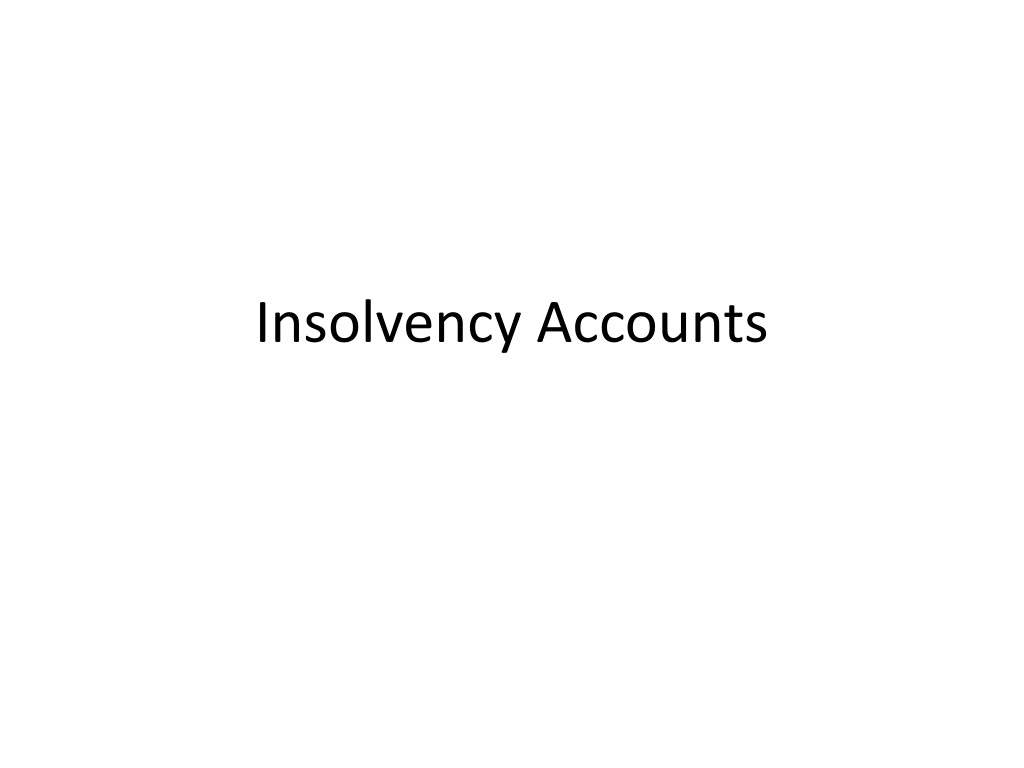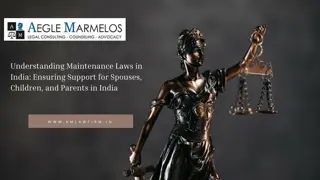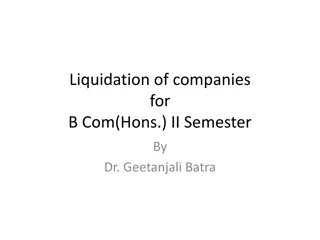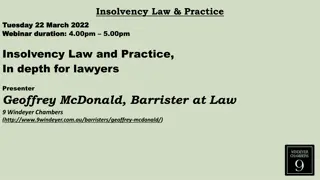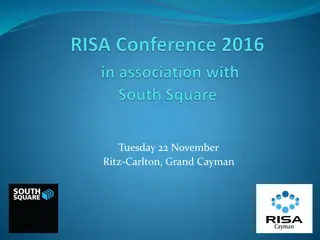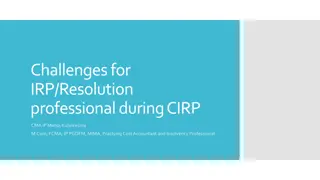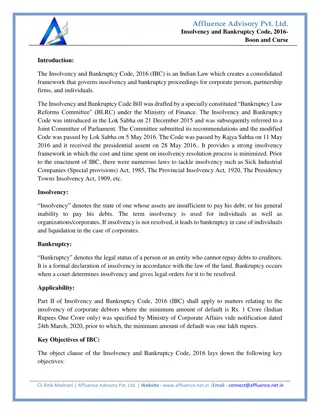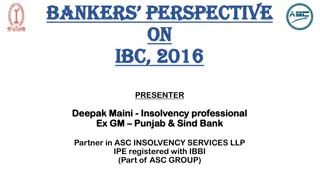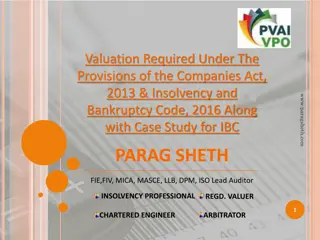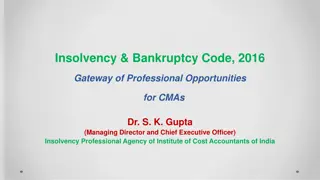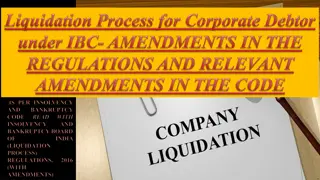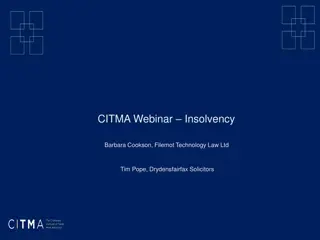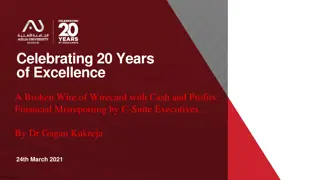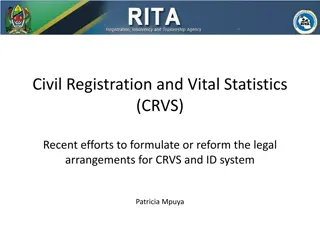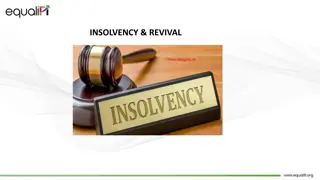Understanding Insolvency Accounts and Laws in India
Insolvency accounts come into play when a debtor is unable to pay debts fully, leading to a legal process supervised by the government for debt resolution. Various scenarios constitute an act of insolvency, such as transferring property to defraud creditors or notifying them of debt payment suspension. India's insolvency laws, including the Presidency Towns Insolvency Act of 1909 and the Provincial Insolvency Act of 1920, provide a framework for managing insolvency proceedings.
Download Presentation

Please find below an Image/Link to download the presentation.
The content on the website is provided AS IS for your information and personal use only. It may not be sold, licensed, or shared on other websites without obtaining consent from the author. Download presentation by click this link. If you encounter any issues during the download, it is possible that the publisher has removed the file from their server.
E N D
Presentation Transcript
Introduction When circumstances, it is not possible for him to pay debts fully. any person has more debts due to various Then he takes shelter of government to get rid of his debts. His property is sold under the supervision of government. The amount realized by sale of his property is distributed amongst his creditors according to the provision of law. Then debtors are freed from his various debts.
Cases when the Act of Insolvency is Committed: The act of insolvency is committed by a debtor in each of the following cases: 1. When a person transfers his property, wholly or partly, to a third person for the benefit of his creditors; 2. When he transfers his property with the intention to defraud or delay his creditors;
3. When he notifies his creditors that he has suspended or is about to suspend payment of his debts; 4. When he departs from or remains out of India; 5. When he departs from his dwelling house or usual place of business or otherwise absents himself; 6. When the debtor is imprisoned in execution of a court degree for payment money;
7. When any of the property of the debtor is sold or attached for a period of not less than 21 days in execution of a degree of any court; 8. When he secludes himself so as to deprive his creditors of the means of communicating with him; 9. When the debtor petitions the court to be adjudged an insolvent; 10. When an insolvent-debtor transfers property or pays a particular creditor in preference to another creditor, more than what he could have got had the insolvent s assets been proportionately distributed amongst all the creditors, he is deemed to have shown fraudulent preference in favour of a particular creditor.
In India, insolvency is governed by two acts namely: 1. The presidency towns insolvency act 1909 2 .The provincial insolvency act 1920 Insolvency word is Bankruptcy word is used in United Kingdom. BY THE WAY used in India and
Presidency towns insolvency act 1909- This act applies in the presidency towns of Bombay, madras and Calcutta. Provincial applies in whole India except the presidency towns of Mumbai, madras and Calcutta. This act applies in other state except Mumbai madras and Calcutta. insolvency act 1920 - THIS act
Differences between presidency towns insolvency act and provincial insolvency act Presidency towns insolvency act 1909 1. All kinds of tax payable to government i.e. sales tax, income tax, and water tax. 2. Workers compensable payable. 3. Salaries to clerk for last four months will not be more than Rs 300 only. 4. Wages payable to worker or servant for last four months will not be more than Rs100. 5. Rent payable to landlord for one month only.
Provincial insolvency act 1920 1. All kinds of tax payable to government i.e. sales tax, income tax, water tax . 2. Workers compensable payable 3. Salaries to clerk for last four months will not be more than Rs20 only. 4. Wages payable to worker or servant for last four months will not be more than Rs20 0nly. 5. No rent will be preferential.
A number of separate lists, called List A to H, are prepared and attached to the Statement of Affairs given above. A Statement of Affairs, like a Balance Sheet, is divided into two parts. Left-hand side of the Statement of Affairs is liability and right-hand side of the Statement is assets.
1. List A-Unsecured Creditors as per List A: This list includes all Creditors, who do not possess any security of the Insolvent Debtor. That is, the Creditors without security fall under this list. Some of such Creditors are: Trade Creditors without security Loan Creditors without security Bank Overdraft unsecured Bills Payable and Promissory Notes Bills Receivable discounted likely to be dishonoured Salary, Wages, Rent etc. over Preferential limit.
2. List B-Fully Secured Creditors: This list includes all the Creditors, who have a claim against the debtor and have obtained a lien, guarantee or possession of some deeds or other securities. That is, the creditors, who have sufficient securities of the insolvent Debtor to meet their claims. The value of the securities may be equal to or more than the amount of their claims. If there is any surplus of securities in the hands of fully secured creditors, such surplus will be shown on the asset side of the Statement of Affairs and will be available for distribution among the unsecured Creditors. For instance, if a loan of Rs 10,000 has been taken on a security worth Rs 15,000, this loan is fully secured. The Surplus of Rs. 5,000 (Rs. 15,000-10,000) is shown on the asset side of the Statement of Affairs.
3. List C-Partly Secured Creditors There are certain Creditors, who have the security for a lesser value than the amount of their claims. That is, the Creditors of this type got only partial security for the loan advanced by them. The securities are insufficient to meet the claims. For instance, a loan of Rs 10,000 has been taken and the security for this loan is only Rs. 6,000. So, the loan is partly secured. The value of the security is not sufficient to cover their claims fully. The excess of loan over the security is shown in the outer column.
4. List D-Preferential Creditors: This list shows the Preferential Creditors, who are entitled to priority over other debts of the insolvent. For instance, taxes, rates, wages, salaries etc. are paid in full. The following is the details of Preferential Creditors under the Presidency Towns Insolvency Act and Provincial Insolvency Act:
The amounts of the Preferential Creditors, who are paid in full, are shown in the inner column and this amount is to be deducted from the available assets. The amount of salaries or wages or rent, in excess over the limit prescribed by the law, shall be included in the list of Unsecured Creditors under List A. All the above four lists, A to D, are shown in liability side of the Statement of Affairs.
The following are the lists shown in the asset side of the Statement of Affairs: 5. List E-Properties: This is a list which includes all the assets of the Insolvent, except Book Debts, Bills Receivable and assets which have not been given as security to Creditors. Here all the assets- unencumbered properties i.e., free assets are shown. For instance, Cash in hand, Cash at Bank, Furniture, Machinery etc. Both book value and realisation value are shown.
6. List F-Book Debts: All the debtors of the insolvent are shown in this list. Good, Doubtful and Bad debts are shown separately. 7. List G Bills of Exchange etc.: This list contains the information about Bills Receivable and Promissory Notes. The book value and the realizable value are shown separately.
8. List H-Deficiency Account: This list shows the deficiency i.e., liabilities of the Debtors over realizable value of his assets. For this purpose a separate Deficiency Account is prepared. (This is explained separately.) Now, after writing the Lists E, F and G, the surplus, as per List B, appears on the liability side, is added to the assets. From this amount, the Preferential Creditors as per List D are deducted. The balance, so arrived, is the amount of assets available for distribution among the Creditors.
Deficiency Account: In addition to various lists- Lists A to List G-the Debtor has to prepare a Deficiency Account which explains as to how the deficiency shown in the Statement of Affairs has arisen. The insolvent debtor is required to account for the loss to the amount of his capital and of his Creditors.
On the left- hand side of Deficiency Account appears: (1) The amount of capital, (2) Increment to the Capital from the business i.e., profits, interest on capital, salaries, commission etc., (3) Additional contributions and (4) Realisation profits etc. On its right side appear all the losses and withdrawals by which capital is decreased. The difference between the two sides represents deficiency and this must agree with the deficiency amount as disclosed by the Statement of Affairs.
Priority of Payments: The Official Assignee or Receiver realizes the assets and distributes the proceeds in the following order of priority: 1. Fully secured creditors, in full 2. Partly secured creditors to the extent they are secured 3. Expenses of realisation and remuneration to the receiver 4. Preferential creditors 5. Unsecured creditors, including uncovered balance of partly secured creditors.
Interest: A creditor is not allowed to claim interest after the date of insolvency. However, if all the claims have been satisfied in full, then till the date of payment, interest @ 6% is allowed. Loan from Wife: If the wife has given the loan to her husband out of her personal property or dowry or self-earned income, then the amount of loan is included in Creditors. But if the wife s loan is out of the money given to her by her husband, then the loan is taken as the capital of Insolvent, that is, such amount is not included in the creditors list.
Illustration 1: What are Preferential Creditors in the following liabilities of an insolvent, Gopal, according to the Presidency Towns Insolvency Act and Provincial Insolvency Act? Also point out the unsecured creditors.
Unsecured creditors as per list A- payable, promissory notes, unsecured amount of bank overdraft, Creditors on open account, bills receivable and expected to be dishonored, amount of salaries and wages which is not preferential. Fully secured creditors as per list B- Loan is lesser than securities. Partly secured creditors as per list c- Loan is greater than securities. Preferential creditors as per list D- wages, rent and rates etc. Bills Salaries,
Sundry assets as per list E- except bills receivable, debtors, assets used on securities, promissory notes. Book debts as per list F 1.Good- out 2. Doubtful- under 3. Bad- under Bills of exchange as per list G bills receivable, promissory notes, bills of exchange Surplus carried away from list B as per contra Preferential creditors as per contra Deficiency as per list H Balancing figure All assets are written in it
Note: An insolvent can apply the petition in the court for insolvency, when his liabilities are more than Rs500 from his assets.
Format of Statement of Affairs: Gross Liabiliti es Expected to rank Estimated to produce liabilities Assets Unsecured creditors as per Sundry assets as per list E List A (EXCEPTS debtors, bills receivable Promisory notes, securities) Assets(estimated value) Bookdebts as per list F Good Doubtful assets used on Fully secured creditors as per list B Partly secured creditors as per list c Preferential creditors as per list D under Bad under Bills of exchange as per list G Surplus carried away from list B as contra Less: Preferential creditors as per contra Deficiency as per list H Surplus
Deficiency A/c Capital Drawings profit Other losses ASSESTS(Estimated value realized) Bad debts Contingent liabilities value- Interest on capital Other expenses (preferential creditors) Wives loan Bills receivable and expected to be dishonored. Deficiency surplus Note- Balancing figure of statement of affairs A/c must be equal to the balancing figure of deficiency account. 2. Amount realized by sale of assets are written in the assets side (estimated to produce) of the statement of affairs.
1. Answer: The main differences between a statement of affairs and balance sheet are as follows: a) The balance sheet of an individual or a partnership firm is not regulated by any act, where as statement of affairs of an individual or a partnership firm is regulated by the Insolvency Act. (b)A balance sheet is usually prepared at the end of each accounting year, whereas a statement of affairs is prepared on the date on which the order of adjudication is passed against the debtor. (c)A balance sheet shows the assets and liabilities as well as the capital of the person . But a statement of affairs shows merely the assets and liabilities of a person but not his capital. (d) A balance sheet includes even fictitious assets, i.e., assets which are not realizable, whereas a statement of affairs does not include fictitious assets. Distinguish between balance sheet and statement of affairs?
2. Answer: According to law, a person cannot be called an insolvent simply because he is unable to meet his liabilities fully. He can be considered an insolvent only when he has been adjudicated (declared) insolvent by a court. An insolvent is a person whose liabilities exceed his assets and who has been adjudicated insolvent by court . 3. What is Deficiency Account ? Answer: A Deficiency Account is the second statement submitted by an insolvent to the court on the passing of adjudication order. It explains how the deficiency, as shown in the statement of affairs under list H, has been brought about. What do you mean by insolvency ?
4. Answer: * The Presidency Insolvency Act of 1909 applies only to Presidency towns of Kolkata, Mumbai and Chennai, where as Provincial Insolvency Act of 1920 applies to the rest of India. * preferential creditors differ in these two Acts. * the court under the Presidency Towns insolvency act to realize the assets of the insolvent debtor to pay off his liabilities is called official assignee . whereas the official appointed Provincial Insolvency Act to realize the assets of the insolvent debtor and to pay off his liabilities is called the officialreceiver . Distinguish between Provincial and Presidency towns Insolvency Act ? The amount fixed as The official appointed by the by the court under the 5. Who are preferential creditors according to Insolvency Act ? Answer: Preferential creditors as per list D refer to those unsecured creditors, who, because of provisions in the insolvency act, have priority over the other unsecured creditors. They are paid in full, if the property of the insolvent is sufficient. Ex: all debts due to the government or local authorities, salary due to clerk, wages due to workers, rent etc.(as per the limits specified in the act).
6. Explain list A in insolvency ? Answer: List A consists of unsecured creditors. It includes all those liabilities of the insolvent, which we have no security. Ex: sundry creditors, bills payable, bank overdraft not covered by securities, loans not covered by any securities and amounts payable on contingent liabilities likely to be dishonored, non-preferential amounts due for salaries, wages and rent.
Q. How do you treat in Insolvency Accounts the Ornaments for wife out of drawings? Answer: When the debtor makes drawings and out of these drawings his wife s ornament are made, later on his wife gives these ornaments to her husband-debtor for payment of his liabilities, in such a case any one of the following methods may be used: The face value of these ornaments is recorded in the inner column ( book value) and the realizable value in the outer column in list E. Difference of face value and realizable value of ornaments is shown in Deficiency Account and the face value of ornaments is deducted from drawings and the reduced drawings are shown in Deficiency Account. Record the realisable value in List E in Statement of Affairs. In the Deficiency Account only the realizable value of the ornaments is shown on the left hand side.No deductions is made out of the drawings. Q. How do you treat Loan from wife? Answer: If the insolvent's wife has given loan out of her personal property ' stridhan' or her self- earned income, the loan is included in creditors (List A). If the loan has been given out of the money given to her by the husband(insolvent), then her postion is not at par with the creditors. The amount contributed in such a case is taken as the capital of the Proprietor (insolovent). Q. How do you treat Reserve for bad and doubtful debt ? Answer: It is recorded in the left hand side of deficiency account because it is a part of profit.
